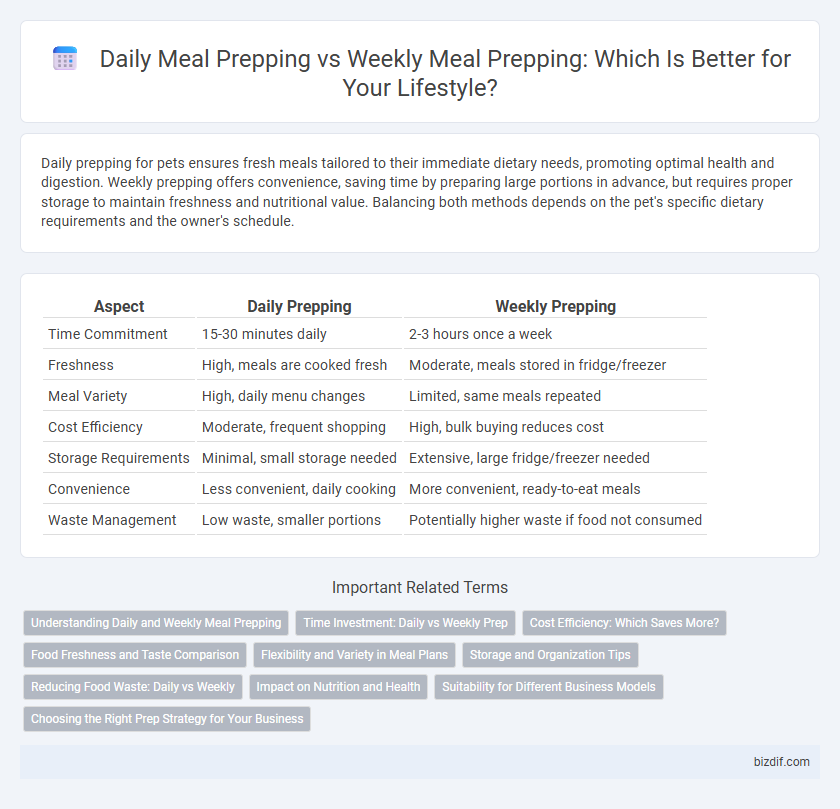Daily prepping for pets ensures fresh meals tailored to their immediate dietary needs, promoting optimal health and digestion. Weekly prepping offers convenience, saving time by preparing large portions in advance, but requires proper storage to maintain freshness and nutritional value. Balancing both methods depends on the pet's specific dietary requirements and the owner's schedule.
Table of Comparison
| Aspect | Daily Prepping | Weekly Prepping |
|---|---|---|
| Time Commitment | 15-30 minutes daily | 2-3 hours once a week |
| Freshness | High, meals are cooked fresh | Moderate, meals stored in fridge/freezer |
| Meal Variety | High, daily menu changes | Limited, same meals repeated |
| Cost Efficiency | Moderate, frequent shopping | High, bulk buying reduces cost |
| Storage Requirements | Minimal, small storage needed | Extensive, large fridge/freezer needed |
| Convenience | Less convenient, daily cooking | More convenient, ready-to-eat meals |
| Waste Management | Low waste, smaller portions | Potentially higher waste if food not consumed |
Understanding Daily and Weekly Meal Prepping
Daily meal prepping allows for fresher ingredients and more variety by preparing meals each day, making it ideal for those with unpredictable schedules. Weekly meal prepping saves time and reduces decision fatigue by cooking in bulk, offering convenience for busy individuals who prefer planning ahead. Both methods improve nutrition and portion control but differ in flexibility and time investment.
Time Investment: Daily vs Weekly Prep
Daily meal prepping requires shorter time commitments each day, typically 20-30 minutes, allowing for fresh ingredients and flexible menus. Weekly prepping demands a larger upfront investment of 2-3 hours but provides convenience by reducing daily cooking tasks and ensuring meals are ready in advance. Balancing time investment depends on individual schedules, preferences, and the need for freshness versus bulk preparation efficiency.
Cost Efficiency: Which Saves More?
Daily meal prepping often incurs higher costs due to smaller, more frequent grocery purchases and potential food waste from unused ingredients. Weekly prepping enables bulk buying, reducing per-unit costs and maximizing ingredient utilization, leading to significant savings. Cost efficiency improves with weekly meal prepping by minimizing impulse buys and leveraging discounts on larger quantities.
Food Freshness and Taste Comparison
Daily meal prepping ensures optimal food freshness and preserves the original taste by minimizing the storage time between cooking and consumption. Weekly prepping offers convenience and time savings but may result in diminished flavor intensity and textural changes due to prolonged refrigeration or freezing. Balancing freshness and practicality depends on individual schedules and preferences for maintaining meal quality.
Flexibility and Variety in Meal Plans
Daily meal prepping offers greater flexibility by allowing adjustments based on changing schedules and cravings, ensuring fresh ingredients and varied meals each day. Weekly prepping provides time-saving benefits but may limit variety, as meals are planned and cooked in bulk, potentially leading to repetitive menus. Balancing both methods can optimize flexibility and variety, tailoring meal plans to individual lifestyle needs and preferences.
Storage and Organization Tips
Daily prepping allows for fresher meals and smaller portions, reducing the risk of food spoilage while requiring less storage space. Weekly prepping demands efficient use of airtight containers and clear labeling to maintain freshness and simplify meal retrieval throughout the week. Utilizing stackable containers and dedicated fridge organizers maximizes space and keeps ingredients systematically arranged.
Reducing Food Waste: Daily vs Weekly
Daily meal prepping allows for more precise portion control and ingredient use, significantly reducing food waste by adjusting meals to immediate consumption needs. Weekly prepping, while efficient for time management, risks increased spoilage if ingredients or meals are not properly stored or consumed promptly. Optimizing storage techniques and selecting versatile ingredients can minimize food waste in both daily and weekly meal prep strategies.
Impact on Nutrition and Health
Daily meal prepping allows for fresher ingredient use, preserving nutrient content such as vitamins C and B, which degrade over time in pre-cooked foods, enhancing overall nutritional intake and supporting immune health. Weekly prepping can save time but may result in nutrient loss and increased reliance on preservatives or reheating methods that reduce food quality and antioxidant levels, potentially impacting metabolic health negatively. Choosing daily prepping promotes better portion control and reduces the risk of oxidative stress linked to nutrient degradation in stored meals.
Suitability for Different Business Models
Daily meal prepping suits food service businesses prioritizing freshness and customization, such as salad bars or made-to-order kitchens, enhancing customer satisfaction with tailored meals. Weekly meal prepping aligns with subscription meal kit services or large-scale catering operations, optimizing batch cooking and inventory management to reduce costs. Choosing between daily and weekly prepping depends on the business model's demand variability, storage capacity, and supply chain efficiency.
Choosing the Right Prep Strategy for Your Business
Daily prepping allows for fresher meals and accommodates menu changes, making it ideal for businesses with high customer turnover or limited storage. Weekly prepping maximizes efficiency and reduces labor costs by batch cooking larger quantities, which suits businesses with consistent menu offerings and storage capacity. Evaluating factors such as menu complexity, staff availability, and storage facilities helps determine the optimal prep strategy to balance quality and operational efficiency.
Daily prepping vs weekly prepping Infographic

 bizdif.com
bizdif.com